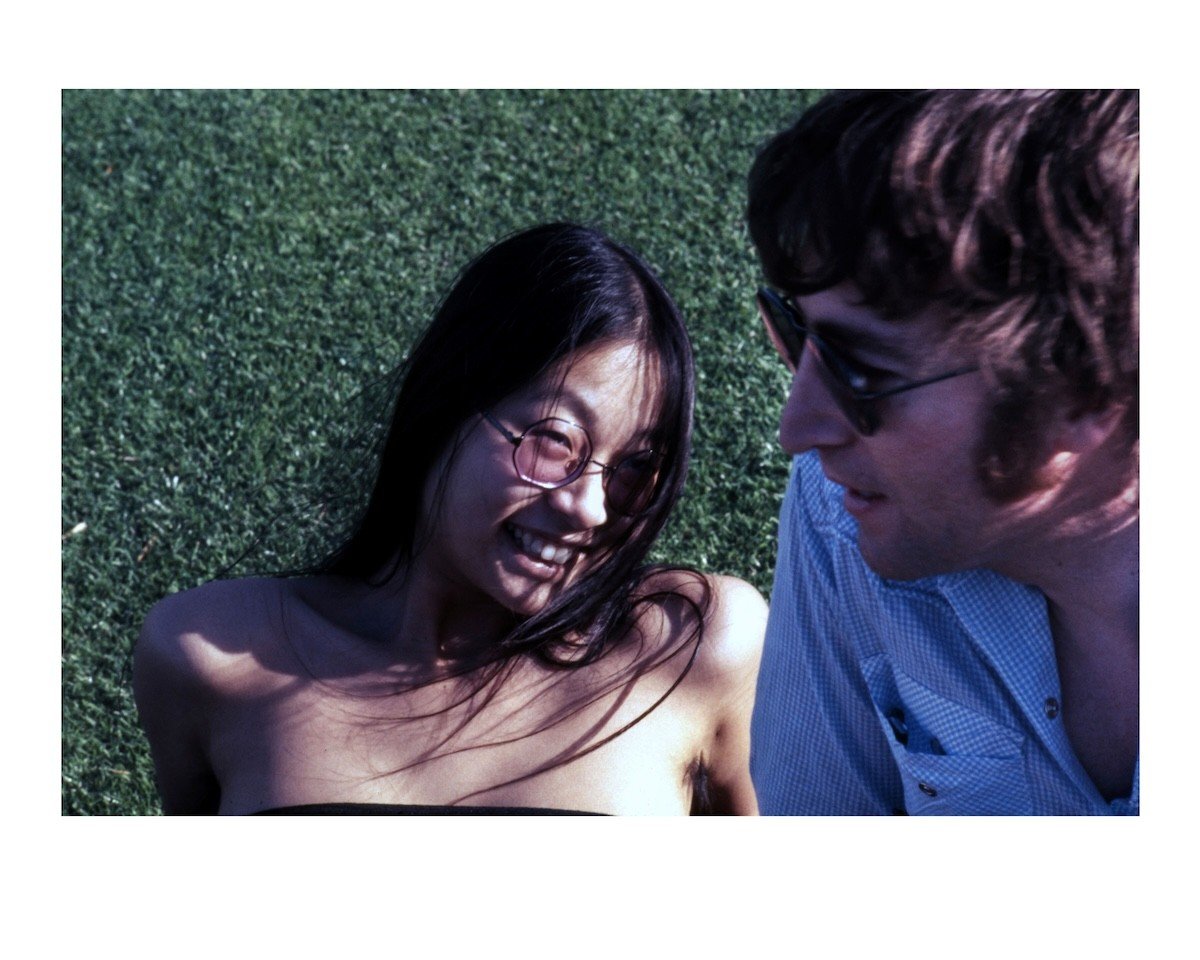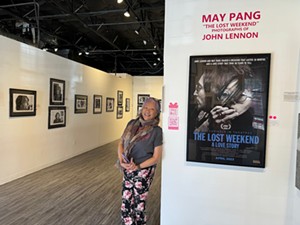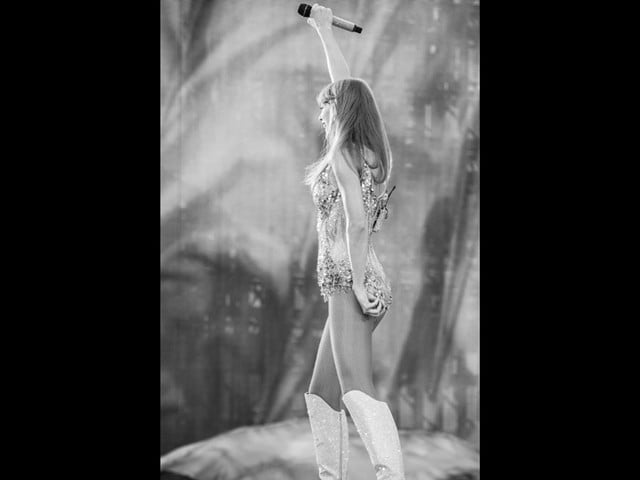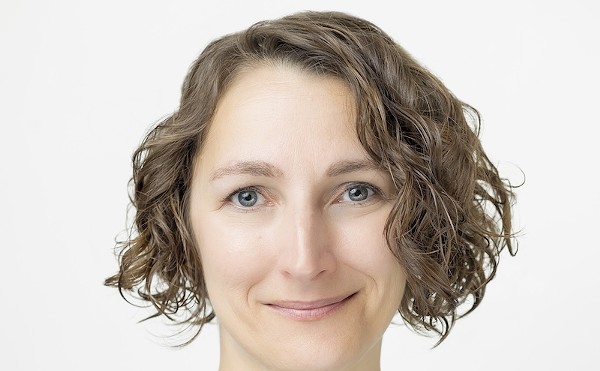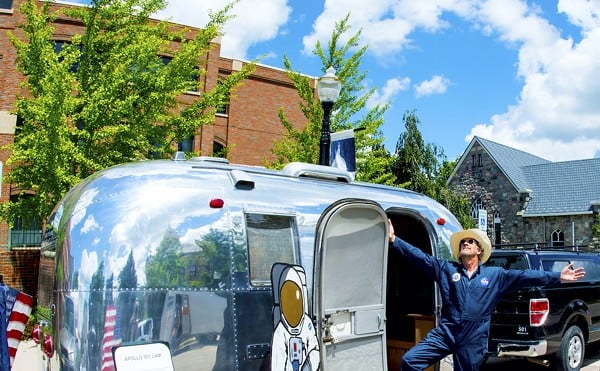This story is featured in CityBeat's April 17 print edition.
May Pang, former assistant-turned-lover of music legend, Beatle and artist John Lennon, spoke with CityBeat about her life, career and their time together ahead of her appearance at Mason’s Gallery 42 for her exhibit, The Lost Weekend: The Photography of May Pang, held on April 30 and May 1.
May Pang’s name is well known in John Lennon history, but not many know the whole story behind their connection. Pang became a recognizable character in Lennon’s life when she transitioned from assistant to companion and romantic partner in a period that saw Lennon enjoying one of the most fun and productive periods in his life and career.
This period came to be known as “The Lost Weekend,” which actually lasted 18 months from the summer of 1973 through the beginning of 1975 — and Pang was there for all of it. The upcoming photo exhibit, The Lost Weekend: The Photography of May Pang, gives some insight into their world and time spent together.
The period stretches across a pivotal time in Lennon’s life and career — the recording and release of Mind Games, Walls and Bridges and Rock 'N' Roll; the release of Harry Nilsson’s Pussy Cats, produced by Lennon; the dissolution of The Beatles; the reintroduction of Paul McCartney into his life and reconnecting with his son, Julian Lennon. Pang was present and often an active participant during these events, photographing all of it.
The exhibit is a complement to The Lost Weekend: A Love Story, the emotional and telling documentary released late last year on streaming platforms after being named a 2022 Tribeca Film Festival Official Selection. The film details her early life and her time with Lennon during one of the most eventful and historic eras of his life and, in turn, hers as well.
Pang is a New Yorker and her poise and good-natured charm immediately come through with her slight and at times charmingly thick New York accent. She still lives in the city and our talk took place shortly after the unnerving earthquake felt in New York that morning that she recalls with the familiarity of an old friend.
She is lively at times as she recalls memories with a laugh, such as the time she got lost on a walk on Lennon and Ono’s large Tittenhurst Park estate while working as an assistant to the couple. She also recalls with excitement an old notebook she recently found that depicts the level of events at the time. “Reminder to tell John and Yoko that they’re having dinner tonight and they’re sitting at the Secretary General’s table, U Thant,” she reads from one entry. (Thant was Secretary-General of the United Nations at the time).
She also speaks with a tone of seriousness on occasion, such as when she talks about deciding to tell her story with the new documentary, recalling her time as his partner after their history was sometimes diminished, in a way, or when people try to lay claim to Lennon connections of the era she knows aren’t completely true.
“Then when I saw how my storyline was being told you know, I said, ‘Wait a minute, I got to take back my narrative here. This is not the way it happened,’” Pang tells CityBeat.
Pang found her way into the music world through her rare upbringing. She says she felt “ostracized, in a way” being the first in her family born outside of China, “You’re not from there, you’re different. So, I found music.” Also, the family didn’t live in Chinatown like many other Chinese immigrant families, but in Harlem — then Spanish Harlem. “So, there were my roots,” she tells CityBeat as she recalls music in the streets on hot summer days and on TV.
“At the time, there’s American Bandstand and you just said, ‘ah,’” she says, still swooning and with an almost invisible exclamation mark. “Music just sort of soothed my soul — it just fed all that went on and it just took me away. It’s like that Carole King song ‘Up On the Roof’ — ‘all your cares go away.’”
In 1970, at age 19, Pang got a job doing clerical work for ABKCO Records, which handled the Apple Records catalog along with The Rolling Stones, the Cameo-Parkway label and much more. Pang says the company moved into new offices and had varying open spots that she was able to fill, gaining experience in different jobs along the way.
By 1971, she worked exclusively for Lennon and Ono, where she helped organize their lives, among other things, between press, work and visits from famous friends like Bob Dylan and George Harrison. She was present for much of their work, such as the making of the iconic video for “Imagine,” with Lennon at the piano in the open white room of Tittenhurst. Pang says, “I remember that day.”
In 1973, at 22, she was approached by Ono to become Lennon’s partner when the couple began having problems.
“I looked at her like, ‘I’m not interested.’” They had been her bosses for the last couple of years, after all. “I knew every aspect of their daily lives, what it was like. I liked going home and just relaxing.” She says the only reason she changed her mind was that Lennon, who was also apprehensive at first, began to pursue her. She resisted still, for a time, before the two fell for each other.
The photos in the exhibit depict their interior life together at this time at home, as a couple on vacations at Disneyland with Julian, out and about with Nilsson and others, or at work in studios or behind the scenes on now-iconic photo shoots.
Lennon continued working and Pang continued working with him but adds, “I was not paid during the time I was living with John. I was with John as a boyfriend/girlfriend situation, not as people would think, as a paid employee or whatever else.”
Lennon was productive, despite initial hard partying with friends like Nilsson, Ringo Starr and Keith Moon, but Pang helped keep things on track.
“He would say, ‘Hey, listen I want to go into the studio, I want to record,’” she tells CityBeat of her role in his work. “I would say, ‘Where do you want to do it? Who do you want to do it with? What musicians do you want?’ And I would do all the prep work and then make sure that everybody got the sheets that they needed for songs, the equipment that John wanted, what musicians that he really wanted to make what songs and, of course, (for) the overdubs, what horn players or what string players and all sorts of things and if one wasn’t available, I had to find another.”
She also added to tracks in more directly recognizable ways like singing backup on the now Christmas classic, “Happy Xmas (War is Over),” and with a memorable, breathy whispered ‘John’ on Lennon’s “#9 Dream” from Walls and Bridges. Pang is credited as production coordinator on Walls and Bridges and later as “Production Co-ordinator and Mother Superior” on Rock 'N' Roll.
Featured in the exhibit, Pang also took one of the last photos of Lennon and McCartney together (there’s another from the same day in Beatles roadie and lifelong friend, Mal Evans’ book, Living the Beatles Legend: The Untold Story of Mal Evans with Linda McCartney, Nilsson and Pang also pictured).
She recalls how the photo came to be in 1974 when Lennon and McCartney reconciled after years of silence since The Beatles’ breakup with a random visit to the studio from Paul and Linda McCartney at the end of a session. “I just happened to be facing the door and Paul and Linda walked in and it was like, ‘Oh my god, Paul and Linda.’ I had this look on my face and John heard me say it and he just turned around and he looked at him and he goes, ‘Hello, hey Paul.’ It was like as if they had just seen each other and it wasn’t in years. It was quite interesting.”
She also participated in what would be the last time the two would play music together after the session. The impromptu jam, which Pang calls a “good icebreaker,” also included Stevie Wonder on keyboards with Pang and Evans playing tambourines.
After Pang and Lennon got an apartment in New York, the McCartneys were their first visitors and Pang says they visited “many times” whenever they were in the city. They were also potentially one of the last visitors just before Lennon would eventually go back to Ono in early 1975.
Pang continued work in the music business after her time with Lennon, working behind the scenes at Island Records, ABC Radio and eventually in publishing for United Artists. She would marry another music legend, producer Tony Visconti, and have two children before a divorce in 2000.
Pang says she’s enjoying getting out to different parts of the country for the exhibitions. “You know, you get New York and L.A., but middle America, I wanna see.” She also mentions the fun of talking with people at the galleries.
“I was taking these photos for me and John, just so we could look and see if anything was interesting,” Pang says. “(I) didn’t think 50 years later it was going to be sitting on the wall. I’m glad I can give a different side of John that no one’s seen because these are not posed; they’re very candid home shots. So they can actually see what John was like and not what they read in the papers.”
Gallery 42 in Mason will host The Lost Weekend: The Photography of May Pang on April 30 from noon to 8 p.m. and May 1 from noon to 7 p.m. Pang will be in attendance. More info: artenclave.com/collections/gallery-42.

